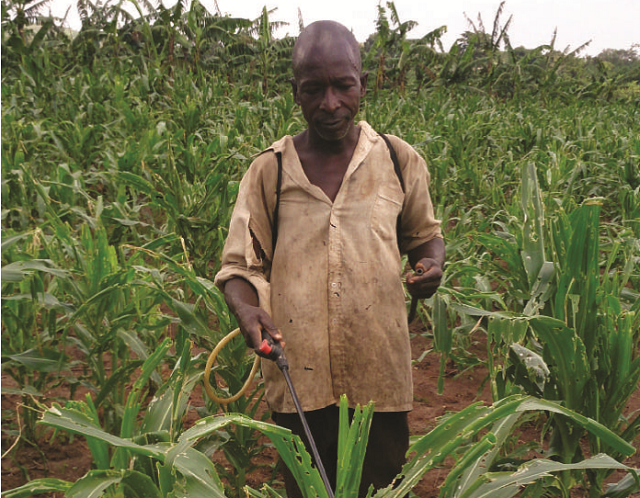
Kampala, Uganda | THE INDEPENDENT | The National Agricultural Research Organization- NARO has asked farmers to use different pesticides to destroy fall armyworms.
Winfred Aol Opio, an entomologist at NARO says that the worms become resistant to a single pesticide when used for two or more consecutive seasons in the same garden.
She says that farmers should rotate or inter-change chemicals after at least one season because it will reduce the rate of destruction of the armyworms.
Fall armyworms have the capacity to cause extensive defoliation, often leaving only the ribs, and stalks of plants with reduced output of the crop.
Allan Tekkara, the Research Officer entomology at NARO says besides the use of organic methods of fighting the worm-like; ashes and red pepper, government has also provided a number of effective pesticides including among others; chlobenzo, rocket, striker, prove, engeo, supa profenofos and hitchel. He adds that farmers should use the right pesticides at the right time, in order to have effective outcome.
He advises farmers to spray at least three times within a season. According to Tekkara, spraying times should be at 11 am and 4 pm to avoid resistance of the pest.
“We always advise farmers to spray their crops at around 11 am and 4 pm after 14 days as this helps to break resistance of the pests and avoid wastage. Spraying should stop immediately the maize tussle is out”, he said.
The government through the Ministry of Agriculture, Animal Industry and Fisheries (MAAIF) with support from United Nation’s Food and Agriculture Organization FAO is currently piloting the use of a mobile phone application dubbed the Fall Armyworm Monitoring and Early Warning System (FAMEWS), in 15 districts.
The districts include Iganga Soroti, Nakapiripirit, Bulambuli, Kiryandongo, Oyam, Adjumani, Kibaale, Kasese, Mukono, Lira, Kayunga, Busia, Masindi and Luwero.
Government has also supplied lures and pheromone traps in the districts to help in detecting the presence and build-up of fall armyworms in areas where the traps are deployed.
Pheromones are natural compounds emitted by female fall armyworm moths to attract male moths for mating which are then trapped.
The number of fall armyworm moths trapped are then recorded on the mobile app and submitted to FAO central platform with countries having rights to access and validate.
From the numbers trapped, farmers can know if fall armyworm is present in their crop fields or area.
*****
URN
 The Independent Uganda: You get the Truth we Pay the Price
The Independent Uganda: You get the Truth we Pay the Price



